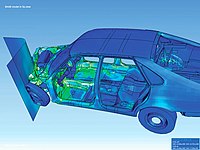
Photo from wikipedia
When the transport equation is solved by the discrete ordinate method, the problem arises of constructing quadrature formulas on a sphere characterized by the required accuracy and making it possible… Click to show full abstract
When the transport equation is solved by the discrete ordinate method, the problem arises of constructing quadrature formulas on a sphere characterized by the required accuracy and making it possible to use the quadrature nodes to approximate the transport equation in $$r,\;\vartheta ,\;z$$ geometry, in which quadrature nodes are simultaneously used to approximate the derivative with respect to the azimuth angle $$\varphi $$ of the transport equation, that is, must be located in levels on the sphere with the same values of the polar angle $$\theta $$ . An algorithm is considered to construct quadrature formulas of the needed form that are characterized by regular prism (dihedron) symmetry and exact for all spherical polynomials of degree not exceeding some maximal value $$L$$ . This study is a development of the work of A.N. Kazakov and V.I. Lebedev (1994). The constructed family of quadratures, unlike that in the above work, does not contain nodes with $$\varphi = 0,{\pi \mathord{\left/ {\vphantom {\pi 2}} \right. \kern-0em} 2},\pi ,{{3\pi } \mathord{\left/ {\vphantom {{3\pi } 2}} \right. \kern-0em} 2}$$ , at the poles $$\theta = \pm {\pi \mathord{\left/ {\vphantom {\pi 2}} \right. \kern-0em} 2}$$ , and on the equator $$\theta = 0$$ of the sphere. It is shown that this family ensures a significant computational gain when radiation transport problems are solved in three-dimensional geometry.
Journal Title: Computational Mathematics and Mathematical Physics
Year Published: 2020
Link to full text (if available)
Share on Social Media: Sign Up to like & get
recommendations!